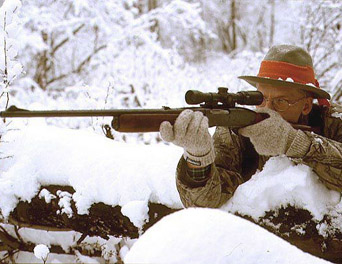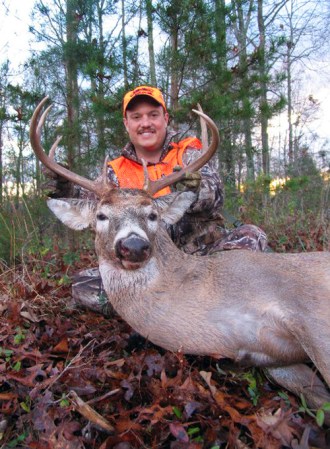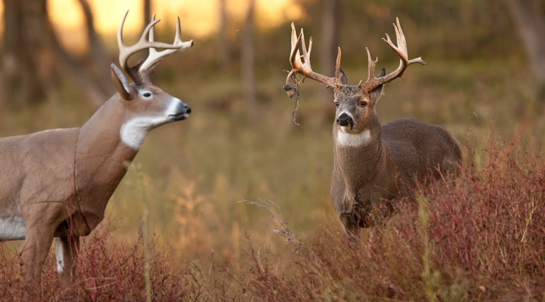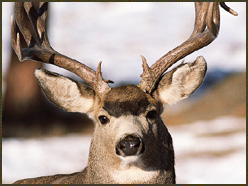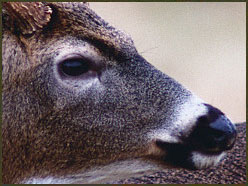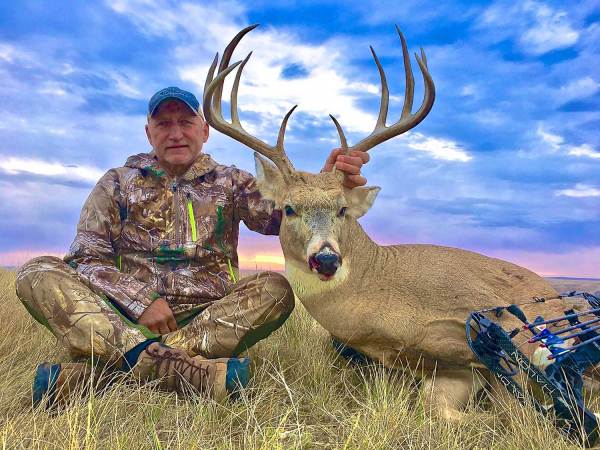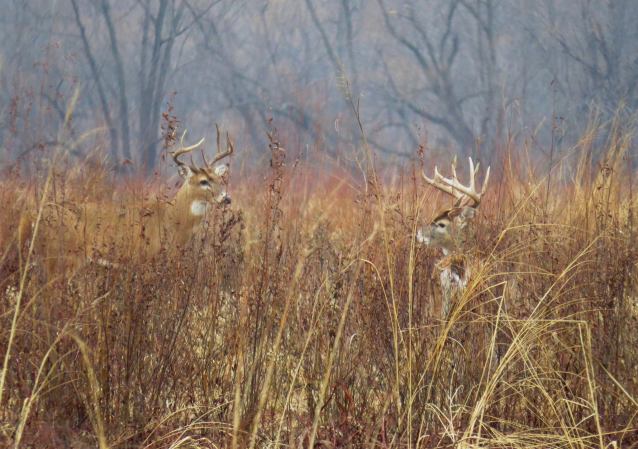It’s hard to imagine any deer behavior generating more interest among hunters than the whitetail rut. It is also hard to come up with any behavior more capable of influencing prospects for hunting success and yet be so widely misunderstood. While our understanding of the rut is evolving annually, most hunters continue to think of it as being punctual, universal, and easily defined. Recent study indicates that it is none of those.
For decades, writers and whitetail experts have advanced the notion of rut stages. According to most so-called gurus, the rut progresses through a set of behavioral phases or stages, which unfold in a more or less orderly fashion among an entire region’s deer herd. These stages are typically labeled with one-word descriptors with models having up to six phases. To listen to some accounts, at any given time on any given day, all the bucks in an area will be chasing does or rubbing trees or breeding or exhibiting some other predictable behavior associated with the rut. That is not what’s happening in the woods.
For the past five years or so, my son Neil and I have been circulating a rut-tracking report, which goes out to thousands of serious deer hunters. As a result, we receive hundreds of reports each week of the season (September through December) representing thousands of data points. We are also in the woods every day (Neil as a practicing wildlife consultant and me as a hermit-hunter living on a mountain). We hunt whitetails almost every day of our season and we have access to an amazing deer-hunting laboratory (see “The Whitetail Lab“), which allows us to observe upwards of 600 acres of prime deer habitat, and usually a dozen or so different deer, at any given time. And what we’ve learned is that the rut is anything but orderly.
The Hunter’s Peak
Ask most hunters to define the peak of the rut, and they will say something about when does are being bred. Drill down a little deeper and they will regale you with tales about bucks marching by treestands every hour on the hour, a dozen buck sightings in a single day, increases in mature buck sightings, and roaming gangs of bucks chasing frantic does. Problem is, while most hunters associate the peak of the rut with breeding, the behaviors they are actually describing are more associated with pre-breeding. Rarely, for example, do they mention anything about seeing bucks breeding or even tending does (being highly attentive, licking flanks, partial mounting, bedding with, etc.). Their working definition of the peak of the rut is all about action and seeing bucks. For all intents and purposes, it should be referred to as the “hunter’s peak.”
The Biological Peak of the Rut
Now, mention peak of the rut to a biologist or anyone else who keeps track of breeding dates, and you’ll learn that the true peak occurs when actual physical breeding is taking place or on those days when the most fawns are conceived. This biological peak of the rut is not necessarily a period of high activity in the woods (that comes earlier). Our review of between 80,000 and 100,000 photos each year confirms it. Buck sightings and photo counts are quite low during the breeding period, or the biological peak of the rut.
Are we splitting linguistic hairs over the rut? I don’t think so. Getting the rut right is the single most important thing a whitetail hunter can do to improve his chances of success. Understanding the difference between the hunter’s peak and the biological peak can mean the difference between the best week of hunting you’ve ever had and just another week in the woods.

Real-Life Rut Tracking
Although there are certainly some general patterns of rut-related behavior among whitetails, Neil and I do not subscribe to the popular and frequently misunderstood notion that the whitetail rut progresses in a regimented, predetermined sequence of behaviors. Similarly, allowing a single isolated observation and a misinformed notion that deer experience the rut in unison can lead to poor hunting decisions.
Last fall, for example, we received a report from a Pennsylvania hunter who declared on October 7: “Early rut this year! We are in full chase mode here in PA. Saw two bucks chasing a doe yesterday.”
One chase observed in early October does not the rut make. His report of the two bucks making chase was no doubt accurate (and useful), but the conclusion that the rut was in full swing was definitely off the mark.
If any doe anywhere comes into heat in early October and stands for a buck a month prior to the biological peak, she will get bred. The bucks really don’t care that they haven’t proceeded through the seeking or chasing stages. If she’s ready, they’re ready. He may catch a certain pheromone on the wind or sense something in her urine that triggers this behavior. And any of the above can happen on any given day in any October, November, or even December in most parts of whitetail country.
At the property we call The Laboratory, it is not unusual to observe three or four different types of rut-related and non-rut-related behavior at the same time. Fat Boy might be locked down with a hot doe in a goldenrod field while Drop Tine marches by 50 yards downwind and ignores the whole thing. Wide Rack may be chasing a doe around a brush lot while Rag Horn watches from a bed on a nearby knoll. Rut-related behavior? Yes. Proceeding in lockstep or even a predictable fashion? Not really. Over time, we have come to understand that anything can happen once bucks shift their focus from finding food to finding does.
A Better Approach: Rut Markers
What we’ve developed is a different way of tracking the rut. First of all, we describe behaviors rather than labeling them, and we never base an opinion on a single observation. Unlike most existing rut models, we look at multiple behaviors of multiple bucks, does, and fawns in our rut-tracking formula. This provides us with fuller and richer descriptions of what is occurring in the woods and generally prevents us from drawing erroneous conclusions from insufficient data.
So how do you know for sure that the hunter’s rut is on if you don’t have a 600-acre whitetail laboratory at your disposal? For starters, gather as much information as possible. We use cameras, keep camp journals, drive backroads, count roadkills, and compare notes with other hunters. Certain behaviors are viewed as meaningful, others are not. It all depends on how they are bundled.
For example, we all recognize certain behaviors to be rut-driven (e.g., chasing). We also associate these specific behaviors with different degrees of rut progression (bucks licking standing does equals breeding). But because we bundle numerous behaviors together, there is a great deal of flexibility in selecting which behaviors to add to the bundle.
This rut-marker approach to tracking the rut provides us with fuller and richer descriptions of what is occurring in the field and seldom leads to rut miscalls and inefficient use of hunting time. You only have so many days to hunt, and you don’t want to be telling your buddies that the rut is on when they should be home raking leaves, nor should you declare that the rut is over when you should be camped out in a treestand.

Period 1: Easy Living
Rut Markers
– Doe and fawn groups intact (above)
– Bachelor buck groups intact
– Mature bucks observable during daylight hours
– Velvet shedding
Field Conditions
Deer are still in their late-summer feeding pattern. As evening approaches and temperatures cool, deer are up and feeding throughout the night. Bucks maintain this pattern until rising testosterone begins to drive rut-related behaviors.
Hunting Strategy
This is a goodtime to locate and pattern mature bucks by keying on feeding patterns. Scout and hunt using low-impact tactics–too much pressure might result in feeding-pattern disruption and turn mature bucks nocturnal. This is a good time to harvest does (or younger bucks) over food sources. Set up on trails leading to and from feeding areas, on small hunting plots, or near mast sources. Soft mast (apples, berries, persimmons) generally matures early and is available, as are some crop foods like clover and alfalfa.
Evening hunts are usually the most productive, as it is difficult to get between feeding deer and bedding cover. If you try to slip in early for a morning hunt, you run the risk of spooking deer. Hot, dry summers make hunting near water sources very productive in some areas. Also, warm-weather bucks will move more with sudden drops in temperature or cooling rain. Rattling is unproductive while bucks are concentrating on food.

Period 2: Ramping Up
Rut Markers
– Doe and fawn groups intact
– Bucks disperse, are on the move
– Mature bucks primarily nocturnal
– oticeable spike in aggressive buck behavior
– Mature bucks exhibit dominance (above)
Field Conditions
Doe and fawn groups are relaxed and focused on feeding. Young bucks are beginning to seek out and harass doe groups, and exhibit rut behaviors such as sparring, rubbing, and scraping. Mature bucks begin to express dominance when in the presence of immature deer, and are primarily nocturnal. Rut sign (rubs, scrapes, etc.) increases.
Hunting Strategy
With most deer bulking up on fall foods, the best hunting will be either on food sources or in ambush spots between bedding areas and food sources. Preferred foods change with availability, especially after a hard frost. This is when deer often move from grazing open fields to working woods foods like hard mast (acorns, beechnuts, etc.) and apples, persimmons, and other soft mast. Now is when paying close attention to the daily weather forecast can pay off in spades. Capable of sensing–and seemingly interpreting–imminent temperature drops, deer will often stream to greenfields ahead of a frost, before palatability wanes. On mornings after a hard frost, look for deer to feed in the corners of greenfields, which are the first to thaw. Fall crops like corn and soybeans are a draw now, too.
As testosterone rises, challenge tactics like rattling and grunting can be effective in areas with numerous bucks. This is a good time to stay out of the woods if you’re hunting mature bucks or you’ll risk turning them nocturnal. Increased human activity often pressures mature bucks to move at night, but younger bucks are still visible.
Deer vocalizations work better now as bucks’ interest begins to grow. Doe and fawn bleats and light buck grunting works. Antler tickling piques curiosity as well. This is better to use on observed deer than calling blindly.

Period 3: The Hunter’s Peak
Rut Markers
– Mature bucks no longer nocturnal
– Fawns without does
– ingle does nervous, scarce (above)
– ucks aggressively pursuing does (top)
– uck sightings outnumber doe sightings
– bnormally high level of buck activity
Field Conditions
Buck behavior is at a fever pitch just prior to breeding, as testosterone levels peak and most does remain unreceptive. Bucks cover greater distances and recklessly chase does. Does avoid food plots and social-gathering areas.
Family units break up due to buck harassment of does. Receptive or near-receptive does attract multiple bucks. Bucks fight for breeding privileges.
Hunting Strategy
This is prime hunting time, as it is generally the time buck activity peaks and one of the few times when a mature whitetail may actually be vulnerable. But know that it typically lasts only a week. The time has come to get in the woods and stay there–all day if necessary. Hunt travel areas like ridges, saddles (between ridges), and natural neck-downs. Food sources are generally less productive because does have been driven from them.
Hunt thick staging areas downwind of food sources. Temperatures 15 degrees or more above average can suppress daytime activity and hunting success, but bucks will be active in windy and rainy weather. Calls, scents, and decoys can all be effective.
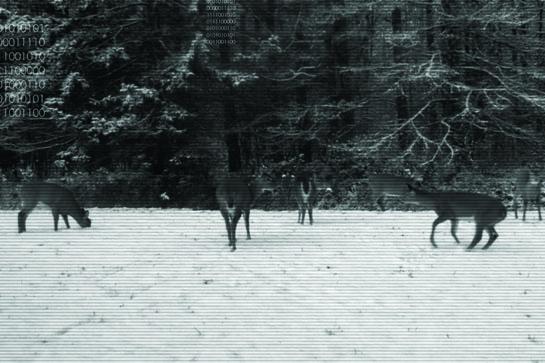
Period 4: The Biological Peak
Rut Markers
-ronounced decrease in all deer sightings
– ther than fawns, few deer on food sources (below)
– ominant bucks tend does with satellite bucks often present
– oes receptive to breeding
Field Conditions
The most noteworthy thing about the biological peak is the marked decline in deer activity. This is principally caused by a sudden increase in estrous does, which are now receptive and no longer avoiding bucks. An abundance of receptive does means fewer bucks moving about looking for does. Bucks will lock down with does in heavy cover or out-of-the-way places for two to three days before relocating to search for other does. Does move very little. Biologically, this is the peak of the rut, or the time when most does conceive.
**
Hunting Strategy**
This is the period of the rut when many hunters erroneously believe that the rut is over and pull out of the woods. Accustomed to seeing great buck action during the hunter’s peak, they get discouraged by the absence of activity. Successful hunters know that true breeding lasts a good 2 to 3 weeks, so they put in their time during the biological peak.
Hunting near or in heavy cover–where bucks and does are locked down–often pays dividends during this time. Funnels and other travel routes can also be good. Forget food sources–they are mainly occupied by fawns and does that have already been bred. Target known doe family bedding cover, as breeding pairs may be in these areas. Hitting multiple stand locations each day often helps to locate a hot breeding zone. Hunt it like a ninja.

Period 5: The Need to Feed
Rut Markers
– Bucks begin to group up again
– oe and fawn family groups reassemble
– ittle rut-related behavior in evidence
– eeding is the dominant behavior (above)
Field Conditions
At the conclusion of the biological peak, whitetails go into a period of early-winter feeding. Bucks have lost up to 25 percent of their body weight due to rutting activity, making feeding and resting their top priorities. Northern deer often feed during the day to avoid heat loss. Bucks will revert to breeding behavior for late-cycling does.
Hunting Strategies
This is a great time to take a top-end buck. It’s best to hunt late-season high-carb and high-protein food sources such as standing corn and acorns. Midday hunts can be productive; late-season deer have been hunted all fall and are often on red alert, which is neutralized somewhat by the need to feed. Wait for ideal conditions before hunting these pressured bucks. Some of the best times to hunt are just prior to, or the day after, a winter storm or when an unusually cold spell ends. Good food sources often spell success at this time of year.






